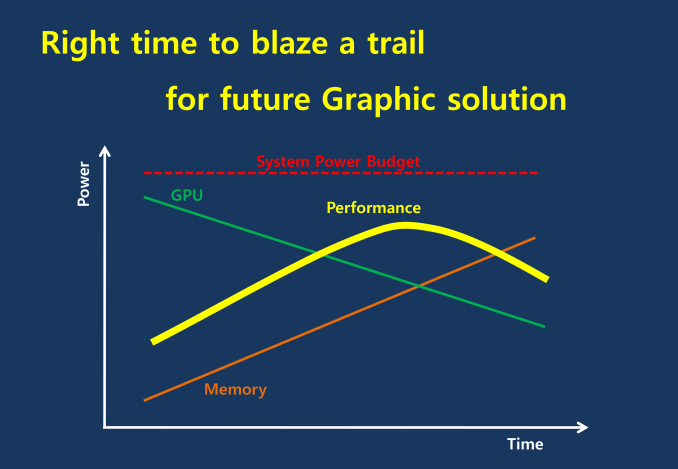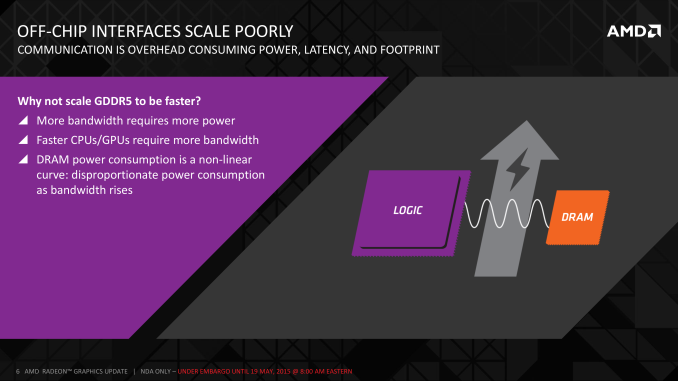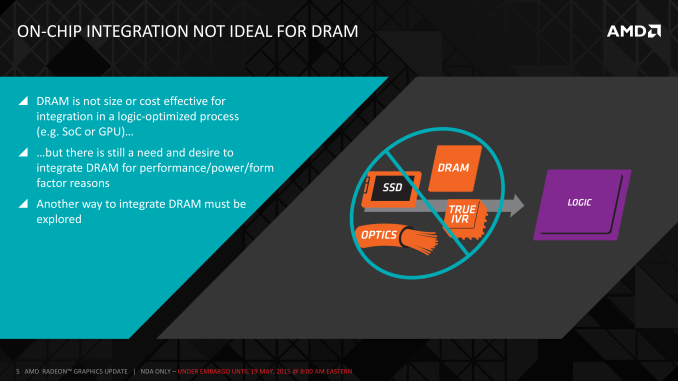AMD Dives Deep On High Bandwidth Memory - What Will HBM Bring AMD?
by Ryan Smith on May 19, 2015 8:40 AM ESTHistory: Where GDDR5 Reaches Its Limits
To really understand HBM we’d have to go all the way back to the first computer memory interfaces, but in the interest of expediency and sanity, we’ll condense that lesson down to the following. The history of computer and memory interfaces is a consistent cycle of moving between wide parallel interfaces and fast serial interfaces. Serial ports and parallel ports, USB 2.0 and USB 3.1 (Type-C), SDRAM and RDRAM, there is a continual process of developing faster interfaces, then developing wider interfaces, and switching back and forth between them as conditions call for.
So far in the race for PC memory, the pendulum has swung far in the direction of serial interfaces. Though 4 generations of GDDR, memory designers have continued to ramp up clockspeeds in order to increase available memory bandwidth, culminating in GDDR5 and its blistering 7Gbps+ per pin data rate. GDDR5 in turn has been with us on the high-end for almost 7 years now, longer than any previous memory technology, and in the process has gone farther and faster than initially planned.
But in the cycle of interfaces, the pendulum has finally reached its apex for serial interfaces when it comes to GDDR5. Back in 2011 at an AMD video card launch I asked then-graphics CTO Eric Demers about what happens after GDDR5, and while he expected GDDR5 to continue on for some time, it was also clear that GDDR5 was approaching its limits. High speed buses bring with them a number of engineering challenges, and while there is still headroom left on the table to do even better, the question arises of whether it’s worth it.

AMD 2011 Technical Forum and Exhibition
The short answer in the minds of the GPU community is no. GDDR5-like memories could be pushed farther, both with existing GDDR5 and theoretical differential I/O based memories (think USB/PCIe buses, but for memory), however doing so would come at the cost of great power consumption. In fact even existing GDDR5 implementations already draw quite a bit of power; thanks to the complicated clocking mechanisms of GDDR5, a lot of memory power is spent merely on distributing and maintaining GDDR5’s high clockspeeds. Any future GDDR5-like technology would only ratchet up the problem, along with introducing new complexities such as a need to add more logic to memory chips, a somewhat painful combination as logic and dense memory are difficult to fab together.
The current GDDR5 power consumption situation is such that by AMD’s estimate 15-20% of Radeon R9 290X’s (250W TDP) power consumption is for memory. This being even after the company went with a wider, slower 512-bit GDDR5 memory bus clocked at 5GHz as to better contain power consumption. So using a further, faster, higher power drain memory standard would only serve to exacerbate that problem.
All the while power consumption for consumer devices has been on a downward slope as consumers (and engineers) have made power consumption an increasingly important issue. The mobile space, with its fixed battery capacity, is of course the prime example, but even in the PC space power consumption for CPUs and GPUs has peaked and since come down some. The trend is towards more energy efficient devices – the idle power consumption of a 2005 high-end GPU would be intolerable in 2015 – and that throws yet another wrench into faster serial memory technologies, as power consumption would be going up exactly at the same time as overall power consumption is expected to come down, and individual devices get lower power limits to work with as a result.
Finally, coupled with all of the above has been issues with scalability. We’ll get into this more when discussing the benefits of HBM, but in a nutshell GDDR5 also ends up taking a lot of space, especially when we’re talking about 384-bit and 512-bit configurations for current high-end video cards. At a time when everything is getting smaller, there is also a need to further miniaturize memory, something that GDDR5 and potential derivatives wouldn’t be well suited to resolve.
The end result is that in the GPU memory space, the pendulum has started to swing back towards parallel memory interfaces. GDDR5 has been taken to the point where going any further would be increasingly inefficient, leading to researchers and engineers looking for a wider next-generation memory interface. This is what has led them to HBM.













163 Comments
View All Comments
chizow - Tuesday, May 19, 2015 - link
I guess we will find out soon enough!chizow - Tuesday, May 19, 2015 - link
@robinspi: Looks like Ryan Shrout at PCPer all but confirms 1xGPU Fiji will be limited to 4GB this round, Joe Macri at AMD was discussing it with him and all but confirms it:http://www.pcper.com/reviews/General-Tech/High-Ban...
"Will gaming suffer on the high end with only 4GB? Macri doesn’t believe so; mainly because of a renewed interest in optimizing frame buffer utilization. Macri admitted that in the past very little effort was put into measuring and improving the utilization of the graphics memory system, calling it “exceedingly poor.” The solution was to just add more memory – it was easy to do and relatively cheap. With HBM that isn’t the case as there is a ceiling of what can be offered this generation. Macri told us that with just a couple of engineers it was easy to find ways to improve utilization and he believes that modern resolutions and gaming engines will not suffer at all from a 4GB graphics memory limit. It will require some finesse from the marketing folks at AMD though…"
Looks like certain folks who trashed the 980 at launch for having only 4GB are going to have a tough time respinning their stories to fit an $850 AMD part with only 4GB.....
Crunchy005 - Tuesday, May 19, 2015 - link
how are you so sure it will be $850? Stop making stuff up before it comes out.chizow - Tuesday, May 19, 2015 - link
How are you so sure it wont' be $850? Stop getting all butthurt and maybe read the typical rumor sites that have gotten everything else to-date correct? 4GB HBM check. X2 check. Water cooled check. And today, multiple sources from these sites saying $850 and a new premium AMD GPU tier to try and compete with Titan.testbug00 - Tuesday, May 19, 2015 - link
that price doesn't make sense given the cost differences between GDDR5 and HBM once you take into account some cost savings that offset a portion of the added HBM cost.I'm guessing if they found a way to make an 8GB version, it would be 800-900 dollars, as, that would eliminate the cost benefits of moving away from GDDR5 as far as I can tell.
a 4GB version I would expect to be 500-550 and 650-700 respectively. Well, to be honest, I personally think they will have 3 different core counts coming from Fiji, given the large cap in CUs from Hawaii to Fiji (given that it has 64 CU, which, everything still points towards)
chizow - Wednesday, May 20, 2015 - link
Huh? Do you think HBM costs more than GDDR5 to implement, or not? There are minor savings on cheaper components/processes, like the PCB, but HBM could be 3-4-10x more expensive per GB; given historical new RAM pricing none of this is that far out there. We also know there's added complexity and cost with the interposer, and AMD is not putting expensive HBM on lower end parts, rebadges, or APUs. This all points to the fact the BoM is high and they are looking to be rewarded for their R&D.In any case, keep hoping for an 8GB (single-GPU version), it seems pretty obvious the 4GB limits for HBM1 are true as AMD is now in full damage control mode saying 4GB is enough.
medi03 - Tuesday, May 19, 2015 - link
Wow another AMD article and again nVidia trolls all over the place.chizow - Tuesday, May 19, 2015 - link
Well, it is always fun to watch AMD overpromise and underdeliver. Oops, was that a troll? :)Horza - Tuesday, May 19, 2015 - link
You know you are chiz that's why you responded to his comment in the first place!chizow - Wednesday, May 20, 2015 - link
Heheh nah, always fun jabbing AMD fanboys like medi03 that I've gone back and forth with over the years, he's been really quiet lately, he may actually be disheartened by AMD's recent bad fortunes, which is uncommon for these die hard AMD fans!